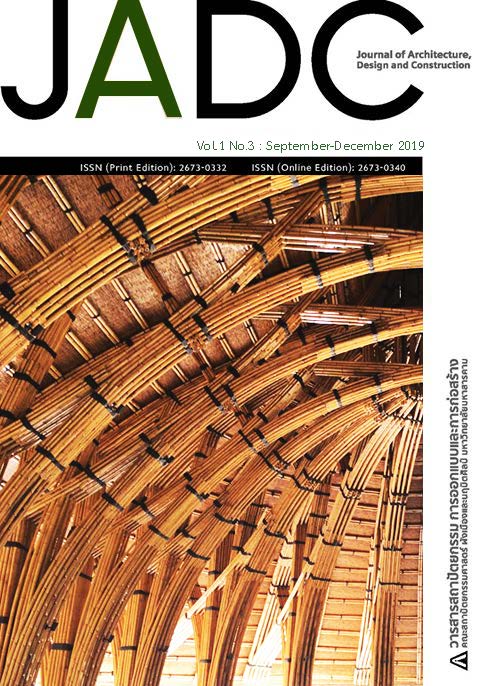การก่อสร้างและค่าพลังงานสะสมรวมวัสดุอาคารผนังดินอัด
Main Article Content
บทคัดย่อ
วัตถุประสงค์ของการวิจัย คือการทดสอบคุณสมบัติของดิน โดยการทดลองใช้ดิน 2 ชนิด คือ ดินเหนียวและดินลูกรัง ที่ผสมแกลบและฟาง และจัดทำตารางเพื่อช่วยออกแบบผนังดินอัดก่อสร้างเพื่อสรุปขั้นตอนและเทคนิค ทั้งคำนวณการถ่ายเทความร้อนจากกรอบอาคาร และหาค่าพลังงานสะสมเปรียบเทียบกับวัสดุผนังอื่น ๆ
ผลการวิจัยพบว่า ค่ากำลังแรงอัดของดินเหนียวจะสูงกว่าดินลูกรัง แรงอัดของดินเหนียวที่มีอายุ 28 วัน คือ 15.02 กก./ตร.ซม. ขณะดินลูกรัง คือ 3.71 กก./ตร.ซม. เครื่องมือที่ได้พัฒนาขึ้นเป็นตารางที่สามารถออกแบบอาคารได้สองชั้น ความหนาของผนัง 40-60 ซม. และ ความสูง 2.50-3.50 ม. ขนาดห้อง 3.00-4.50 ม. ดินลูกรัง เป็นดินที่ถูกนำไปสร้างอาคารผนังดินอัด เพราะที่อยู่ใกล้สถานที่ก่อสร้าง กำลังแรงอัดที่ใช้ในการออกแบบคือ 1.39 กก./ตร.ซม. อาคารผนังดินอัดที่ได้ก่อสร้างมีพื้นที่ใช้สอย 171.00 ตร.ม. สำหรับการก่อสร้างดินอัดใช้แรงงานมากกว่าการก่อสร้างทั่วไป ค่าการถ่ายเทความร้อนรวมของ OTTV อยู่ที่ 22.01 วัตต์/ชั่วโมง การหาค่าพลังงานสะสมวัสดุรวมอาคารผนังดินอัด คือ 11,285.07 กิโลวัตต์ ซึ่งน้อยกว่าผนังอิฐและผนังบล็อกซีเมนต์
Article Details
บทความที่ได้รับการตีพิมพ์เป็นลิขสิทธิ์ของวารสารสถาปัตยกรรม การออกแบบและการก่อสร้าง คณะสถาปัตยกรรมศาสตร์ ผังเมืองและนฤมิตศิลป์ มหาวิทยาลัยมหาสารคาม
References
กาญจน์กรอง สุอังคะ. (2557). รายงานวิจัย การประเมินด้านการประหยัดพลังงานของการออกแบบและการใช้วัสดุก่อสร้างเพื่อการประหยัดพลังงานของบ้านพักอาศัย. นครราชสีมา: มหาวิทยาลัยเทคโนโลยีสุรนารี.
กรมพัฒนาและส่งเสริมพลังงาน กระทรวงวิทยาศาสตร์ เทคโนโลยีและสิ่งแวดล้อม. (2557). รายงานพลังงานของประเทศไทยปี 2542. [ออนไลน์]. ได้จาก: https://www.dedp.go.th, [สืบค้นเมื่อ วันที่ 5 พฤษภาคม 2559].
กรมโยธาและผังเมือง กระทรวงมหาดไทย. กฎหมายด้านโยธาและผังเมือง. พระราชบัญญัติควบคุมอาคาร พ.ศ. 2522. [ออนไลน์]. ได้จาก: https:// https://www.dpt.go.th/th, [สืบค้นเมื่อ วันที่ 20 สิงหาคม 2560].
พิมลมาศ วรรณคนาพล. (2544). ดัชนีพลังงานสะสมรวมของอาคารและวัสดุก่อสรางอาคารในช่วงก่อสร้างและรื้อถอน. ปริญญาสถาปัตยกรรมศาสตรมหาบัณฑิต สาขาสถาปัตยกรรม คณะสถาปัตยกรรมศาสตร์ จุฬาลงกรณ์มหาวิทยาลัย.
Bui, Trung, Quoc-Bao, Maximilien. (2014). Failure of rammed earth walls: From observations to quantifications. Construction and Building Materials, Vol. 51, Issue 15, (pp. 295-302).
Bui, Q.B., Morel, J.C., Venkatarama Reddy, B.v. and Ghayad. (2009). Durability of rammed earth walls exposed for 20 years to natural weathering. Building and Environment, Vol. 44, Issue 5, (pp. 912-919).
Ciancio, Daniela & Beckett, Christopher. (2013). Rammed earth: An overview of a sustainable construction material. Sustainable Construction Materials and Technologies: Proceedings of the 3rd International conference, (pp. 193-198). West Sussex, UK: IMP.
Gerald W. May. (1984). Structural Engineering for Earth Buildings, Adobe and Rammed Earth Buildings: Design and Construction. Tucson: University of Arizona Press, 984. London, Routledge.
Hall M & Djerbib Y. (2004). Rammed Earth Sample Production. Construction and Building Material, Vol. 18, Issue 4, (pp. 281-286).
Jayasinghe, c. and Kamaladasa, N. (2007). Compressive strength characteristics of cement stabilized rammed earth walls. Construction and Building Materials, Vol. 21, Issue 11, (pp. 1971-1976).
Matthew Hall and Youcef Djerbib. (2004). Rammed earth sample production: context, recommendations and consistency. Construction and Building Materials, Vol. 18, Issue 4, (pp. 281-286).
Malhotra, Mini. (2018). EARTHSHACK Showcasing Rammed Earth Construction. Rammed Earth Solar Home. [Online]. Retrieved from https://www.rammedearthhomes.com/technical.html. [accessed 30 May 2015].
McHenry, Paul Graham. (1984). Adobe and Rammed Earth Buildings: Design And Construction. Tucson: University of Arizona.
Miloslave Bagona, Dusan Katunsky. (2010). Embodied Energy of Stabilized Rammed Earth. Energy and Buildings, Vol. 42, Issue 3, (pp. 380-385).
Odum, Howard T., Brown Mark T. and Brandt-Williams, Sherry. (2001). Handbook of Emergy Evaluation. A compendium of Data for Emergy Center for Environmental Policy Environmental Engineering Sciences, University of Florida.
Richard Burt. (2005). Showcasing Rammed Earth Construction. USA. Texas A&M University.

